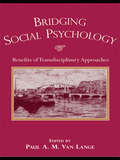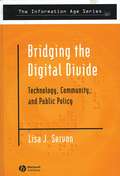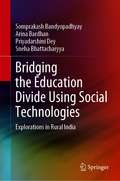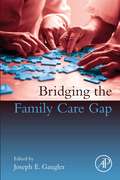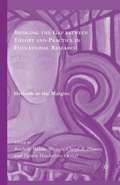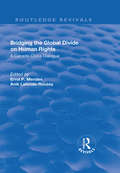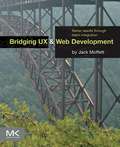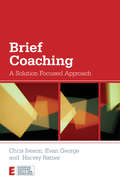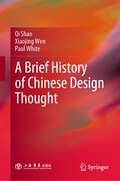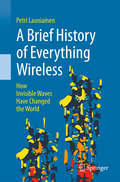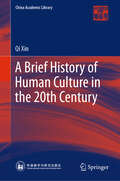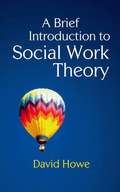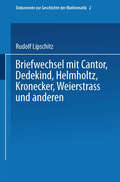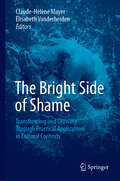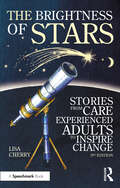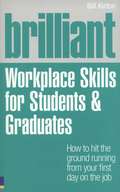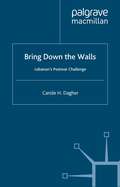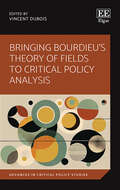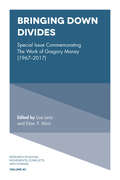- Table View
- List View
Bridging Social Psychology: Benefits of Transdisciplinary Approaches
by Paul A. M. Van LangeBridging Social Psychology illuminates the unique contribution the field of social psychology can bring to understanding major scientific and societal problems. The book focuses on illustrating the benefits and costs of bridging social psychology with other fields of psychology, including cognitive, developmental, and personality psychology, as well as other disciplines such as biology, neuroscience and economics. The editor’s hope is that the examination of these bridges will result in new theoretical, methodological, and societal benefits. The 65 essays, written by eminent leaders in the field, demonstrate the relationship of social psychology with: (1) biology, neuroscience and cognitive science; (2) personality, emotion, and development; (3) relationship science, interaction, and health; and (4) organizational science, culture, and economics. The book also examines the key assumptions of social psychology, where the field is headed, and its unique contribution to basic theoretical and broad societal questions (e.g. promoting health in society). Section introductions tie the book together. The book concludes with an enlightening Epilogue by Walter Mischel.This book will appeal to scholars, researchers, and advanced students in social psychology wishing to demonstrate the cross-disciplinary aspect of their research. It will also be of interest to those in neighboring fields of psychology, especially personality, organizational, health, cognitive, and developmental psychology, as well as those in neuroscience, biology, sociology, communication, economics, political science, and anthropology. The user-friendly tone makes the book accessible to those with only a basic knowledge of social psychology. The book also serves as a text for advanced courses in social psychology and/or applied psychology. A helpful table, found on the book’s Web site, indicates the cross-disciplinary applications addressed in each essay, to make it easier to assign the book in courses.
Bridging Social Psychology: Benefits of Transdisciplinary Approaches
by Paul A. M. Van LangeBridging Social Psychology illuminates the unique contribution the field of social psychology can bring to understanding major scientific and societal problems. The book focuses on illustrating the benefits and costs of bridging social psychology with other fields of psychology, including cognitive, developmental, and personality psychology, as well as other disciplines such as biology, neuroscience and economics. The editor’s hope is that the examination of these bridges will result in new theoretical, methodological, and societal benefits. The 65 essays, written by eminent leaders in the field, demonstrate the relationship of social psychology with: (1) biology, neuroscience and cognitive science; (2) personality, emotion, and development; (3) relationship science, interaction, and health; and (4) organizational science, culture, and economics. The book also examines the key assumptions of social psychology, where the field is headed, and its unique contribution to basic theoretical and broad societal questions (e.g. promoting health in society). Section introductions tie the book together. The book concludes with an enlightening Epilogue by Walter Mischel.This book will appeal to scholars, researchers, and advanced students in social psychology wishing to demonstrate the cross-disciplinary aspect of their research. It will also be of interest to those in neighboring fields of psychology, especially personality, organizational, health, cognitive, and developmental psychology, as well as those in neuroscience, biology, sociology, communication, economics, political science, and anthropology. The user-friendly tone makes the book accessible to those with only a basic knowledge of social psychology. The book also serves as a text for advanced courses in social psychology and/or applied psychology. A helpful table, found on the book’s Web site, indicates the cross-disciplinary applications addressed in each essay, to make it easier to assign the book in courses.
Bridging the Digital Divide: Technology, Community and Public Policy (Information Age Series)
by Lisa J. ServonBridging the Digital Divide investigates problems of unequal access to information technology. The author redefines this problem, examines its severity, and lays out what the future implications might be if the digital divide continues to exist. Examines unequal access to information technology in the United States. Analyses the success or failure of policies designed to address the digital divide. Draws on extensive fieldwork in several US cities. Makes recommendations for future public policy. Series editor: Manuel Castells.
Bridging the Education Divide Using Social Technologies: Explorations in Rural India
by Somprakash Bandyopadhyay Arina Bardhan Priyadarshini Dey Sneha BhattacharyyaThis book explains the concept of education divide in rural India and identifies various factors that shape and sustain such a divide. In doing so, it also discusses a range of attempts undertaken to bridge the education divide. Subsequently, the book has attempted in providing a socio-technical framework towards optimally deploying social technologies for addressing the issue of education divide of marginalized communities. The proposed framework offers a transition from traditional content-centric, teacher-centric and centralized education ecosystem to a connection-centric, learner-centric and decentralized education ecosystem of the socio-digital age. It demonstrates how Internet-enabled digital platforms, based on the principles of sharism and mass collaboration using social technologies, could help to solve one of the greatest problems facing the world: mitigating the extant education divide by delivering quality education to underprivileged sections of society. The book also presents empirical validation of the proposed framework to show how a community-driven blended learning platform can mobilize the dormant knowledge capital of domain experts to teach underprivileged rural Indian children, as well as help form communities of practice to enable lifelong learning for the rural adult population. The book closes by pointing out the challenges involved in building an equitable education ecosystem using social technologies and ultimately the possibility of creating a fair and equitable society. Given its scope, the book offers a valuable resource for researchers, policymakers and practitioners in the domain of education who want to transform education ecosystems by using technological and process-related innovations to improve educational practices for underprivileged sections of society.
Bridging the Family Care Gap
by Joseph E. GauglerBridging the Family Care Gap explores expected future shortages of family caregivers of older persons and identifies potential solutions. The book examines the sustainability and availability of care management models and whether they can be effectively scaled up to meet community needs. It identifies newly emerging policy initiatives at local, state, and federal levels. The book addresses the state of family caregiving science, dissemination and implementation of promising programs and supports, technological innovations, and other strategies to offset the family care gap. This edited volume also explores lay healthcare workers as guides, interpreters, and advocates in healthcare systems that provide continuity of contact for family caregivers.Details threats to family caregiving-sociodemographic, chronic disease, and socioeconomic challengesPresents solutions to the caregiving gap in a systematic, synthesized mannerAddresses the intersection of family caregiving and technologyDiscusses chronic disease management to offset and reduce the need for family caregivingDescribes models of caregiver support in work settingsReimagines the delivery of long-term services and supports with novel initiatives
Bridging the Gap between Theory and Practice in Educational Research: Methods at the Margins
by Rachelle Winkle-Wagner Cheryl A. HunterThis book provides new ways of thinking about educational processes, using quantitative and qualitative methodologies. Ultimately, it aims at expanding knowledge itself - altering the centre by allowing the margins to inform it - allowing it to be extended to include those ways of knowing that have historically been unexplored or ignored.
Bridging the Global Divide on Human Rights: A Canada-China Dialogue
by Errol P. Mendes Anik Lalonde-RoussyThis title was first published in 2003. In this collection of essays that explores Western and Chinese perspectives on human rights, leading Canadian and Chinese scholars bridge the global divide on some of the key aspects of human rights. Issues covered include the role of civil society in human rights protection, the imperative of the rule of law in the protection of human rights, freedom of expression and its relation to social, economic and cultural development and corruption in the public and private sectors. The volume also focuses on the domestic implementation of human rights treaties and offers gender perspectives on implementing social and economic rights in an era of globalization. The independent Chinese and Canadian scholars present a new vision of global pluralism in the area of human rights protection in a modernizing China and in the rest of the world.
Bridging the Global Divide on Human Rights: A Canada-China Dialogue (Routledge Revivals Ser.)
by Errol P. Mendes Anik Lalonde-RoussyThis title was first published in 2003. In this collection of essays that explores Western and Chinese perspectives on human rights, leading Canadian and Chinese scholars bridge the global divide on some of the key aspects of human rights. Issues covered include the role of civil society in human rights protection, the imperative of the rule of law in the protection of human rights, freedom of expression and its relation to social, economic and cultural development and corruption in the public and private sectors. The volume also focuses on the domestic implementation of human rights treaties and offers gender perspectives on implementing social and economic rights in an era of globalization. The independent Chinese and Canadian scholars present a new vision of global pluralism in the area of human rights protection in a modernizing China and in the rest of the world.
Bridging UX and Web Development: Better Results through Team Integration
by Jack MoffettThe divide between UX and Web development can be stifling. Bridging UX and Web Development prepares you to break down those walls by teaching you how to integrate with your team’s developers. You examine the process from their perspective, discovering tools and coding principles that will help you bridge the gap between design and implementation. With these tried and true approaches, you’ll be able to capitalize on a more productive work environment. Whether you’re a novice UX professional finding your place in the software industry and looking to nail down your technical skills, or a seasoned UI designer looking for practical information on how to integrate your team with development, this is the must-have resource for your UX library.Establish a collaboration lifecycle, mapping design activities to counterparts in the software development processLearn about software tools that will improve productivity and collaborationWork through step-by-step exercises that teach font-end coding principles to improve your prototyping and implementation activitiesDiscover practical, usable HTML and CSS examplesUncover tips for working with various developer personas
Brief Coaching: A Solution Focused Approach (Essential Coaching Skills and Knowledge)
by Chris Iveson Evan George Harvey RatnerBrief Coaching offers a new approach to coaching by considering how the client will know when they have reached their goal, and what they are already doing to get there. The coach aims to work towards the solution rather than working away from the problem, so that the client's problem is not central to the session, but instead the coach and the client work towards the client's preferred future. This book employs case examples and transcripts of sessions to offer guidance on: looking for resources rather than deficits exploring possible and preferred futures examining what is already contributing to that future treating clients as experts in all aspects of their lives. This practical guide includes summaries and activities for the coach to do with the client and will therefore be a useful tool for both new and experienced coaches, as well as therapists branching into coaching who want to add to their existing skills.
Brief Coaching: A Solution Focused Approach (Essential Coaching Skills and Knowledge)
by Chris Iveson Evan George Harvey RatnerBrief Coaching offers a new approach to coaching by considering how the client will know when they have reached their goal, and what they are already doing to get there. The coach aims to work towards the solution rather than working away from the problem, so that the client's problem is not central to the session, but instead the coach and the client work towards the client's preferred future. This book employs case examples and transcripts of sessions to offer guidance on: looking for resources rather than deficits exploring possible and preferred futures examining what is already contributing to that future treating clients as experts in all aspects of their lives. This practical guide includes summaries and activities for the coach to do with the client and will therefore be a useful tool for both new and experienced coaches, as well as therapists branching into coaching who want to add to their existing skills.
A Brief History of Chinese Design Thought
by Qi Shao Xiaojing Wen Paul WhiteThis book introduces readers to the history of design thinking in pre-modern China. The content is structured according to successive dynasties, covering the seven major periods of the pre-Qin, Qin and Han, Wei and Jin, Sui and Tang, Song and Yuan, Ming, and Qing dynasties. Each chapter introduces the most representative individuals of the period and discusses their work and ideas in order to reveal the national and cultural features of the respective periods. A distinctive feature of cultural identity running through the long course of China’s historical development is the argument that actions are determined by ideas: Such a view can be found in long-standing thinking on art, design, and creativity. The book demonstrates that conscious design is the vital link between the ideas that constitute human cultures and the physical objects that make up their resulting material cultures. It is the attribute of design that defines what it is to be human and also produces the physical evidence of the evolution of Chinese civilization. The book reveals the integrated characteristics of Chinese culture and art and shows how both changing and recurring ideologies have influenced Chinese design practice since the ancient Shang and Zhou dynasties and how these forces have shaped the spirit and materiality of Chinese civilization. Design is the cornerstone that has made China one of the major contributors to human civilization throughout the thousands of years of its history.Given its focus, the book largely appeals to two main audiences: an academic readership of students and researchers interested in cultural studies and, a more general one, consisting of those interested in international comparisons and wishing to learn more about Chinese history, society, and culture. In order to appeal to both, the book is written in a clear and accessible language.
A Brief History of Everything Wireless: How Invisible Waves Have Changed the World
by Petri LauniainenSince the discovery of electromagnetic waves less than 150 years ago, the application of wireless communications technology has not only revolutionized our daily lives, but also fundamentally changed the course of world history.A Brief History of Everything Wireless charts the fascinating story of wireless communications. The book leads the reader on an intriguing journey of personal triumphs and stinging defeats, relating the prominent events, individuals and companies involved in each progressive leap in technology, with a particular focus on the phenomenal impact of each new invention on society. Beginning at the early days of spark-gap transmitters, this tale touches on the emergence of radio and television broadcasting, as well as radio navigation and radar, before moving on to the rise of satellite, near-field and light-based communications. Finally, the development of wireless home networks and the explosive growth of modern cellular technologies are revealed, complete with a captivating account of their corresponding company histories and behind-the-scenes battles over standards.For those wishing to peek behind the magic curtain of friendly user interfaces and clever engineering, and delve further into various processes underlying the ubiquitous technology we depend upon yet take for granted, the book also contains special “TechTalk” chapters that explain the theoretical basics in an intuitive way.
A Brief History of Human Culture in the 20th Century (China Academic Library)
by Qi XinThis book examines the cultural concepts that guided the development of the “age of mankind”— the changes that took place in historical, philosophical, scientific, religious, literary, and artistic thought in the 20th century. It discusses a broad range of major topics, including the spread of commercial capitalism; socialist revolutions; the two world wars; anti-colonialist national liberation movements; scientific progress; the clashes and fusion of Eastern and Western cultures; globalization; women’s rights movements; mass media and entertainment; the age of information and the digital society. The combination of cultural phenomena and theoretical descriptions ensures a unity of culture, history and logic. Lastly, the book explores the enormous changes in lifestyles and the virtualized future, revealing cultural characteristics and discussing 21st -century trends in the context of information technology, globalization and the digital era.
A Brief History of Schooling in the United States: From Pre-Colonial Times to the Present (The Cultural and Social Foundations of Education)
by Edward JanakThis book presents a sweeping overview of the historical and philosophical foundations of schooling in the United States. Beginning with education among the indigenous peoples of the Americas and going on to explore European models of schooling brought into the United States by European colonists, the author carefully traces the arc of educational reform through major episodes of the nation’s history. In doing so, Janak establishes links between schools, politics, and society to help readers understand the forces impacting educational policy from its earliest conception to the modern day. Chapters focus on the philosophical, political, and social concepts that shaped schooling of dominant and subcultures in the United States in each period. Far from being merely concerned with theoretical foundations, each chapter also presents a snapshot of the “nuts and bolts” of schooling during each period, examining issues such as pedagogical devices, physical plants, curricular decisions, and funding patterns.
A Brief Introduction To Social Work Theory (PDF)
by David HoweLearning about social work theory is a bit like hot air ballooning - it's about looking at the world from above and going on a voyage of discovery to find out what guides social work practice. In 25 clearly labelled chapters, this book explains and discusses social work theory in a crisp, clear and accessible way. Whether you're a student, a newly qualified social worker or a 'seasoned' professional you will find plenty in this book to inform, enlighten and refresh you. Written by David Howe, one of the top British writers in social work, his simple, easy-to-read style makes this text ideal for quick reference in lectures, on placement or in practice. A Brief Introduction to Social Work Theory manages to be both compact and comprehensive. You will return to this 'can't live without it' text time and time again.
Briefwechsel: Band 1 (René König Schriften. Ausgabe letzter Hand #19)
by Mario König Oliver KönigVon René König liegt ein umfangreicher Briefwechsel vor, der von den 20er bis 90er Jahre reicht. Er verdeutlicht die Vielfalt der persönlichen, intellektuellen und beruflichen Freundschaften und Kontakte, die mit dem ebenso umfangreichen wie vielseitigen wissenschaftlichen, literarischen und journalistischpopulären Werk verbunden sind. Die Schriftenreihe legt eine Auswahl dieses Briefwechsels in zwei Bänden vor. Der erste Band umfasst den gegenseitigen Briefverkehr von René König mit zentralen Vertretern der Soziologie in der Gründungsphase nach dem 2. Weltkrieg: Theodor W. Adorno, Max Horkheimer, Helmut Schelsky, Otto Stammer, Leopold von Wiese. Die Zeit der Neubegründung der Soziologie in Deutschland nach dem 2. Weltkrieg ist nicht nur fachsoziologisch, sondern auch zeitgeschichtlich von Interesse, da die exponierten Vertreter der Soziologie in diesen Jahren wesentliche gesellschaftliche und kulturelle Positionen repräsentierten und auch gesellschaftlich auf die Entwicklung der Bundesrepublik Einfluss zu nehmen versuchten. Der vorliegende Briefwechsel beschäftigt sich mit inhaltlich-fachlichen, universitäts- sowie institutionspolitischen Fragen im Zusammenhang mit der 1946 wiedergegründeten Deutschen Gesellschaft für Soziologie (DGS).
Briefwechsel mit Cantor, Dedekind, Helmholtz, Kronecker, Weierstrass und anderen (Dokumente zur Geschichte der Mathematik #2)
by Rudolf LipschitzEin Abdruck des gesamten Briefwechsels würde etwa 1500 Seiten erfordern, kam also nicht in Betracht. Es wurde versucht, die interessantesten Briefe herauszusuchen, aber die getroffene Aus wahl ist sicher subjektiv und teilweise willkürlich. Es wurde nicht einmal versucht, nach formal einheitlichen Kriterien vor zugehen. Z. B. wurde der Briefwechsel mit Dedekind und Kronecker in großen Teilen vollständig aufgenommen, weil hier auch Lipschitz' Briefe vorhanden sind und vor allem der Briefwechsel mit Dedekind historisch von besonderer Bedeütung ist. Aus ande ren Korrespondenzen wurden oft nur einzelne Briefe oder Teile einzelner Briefe ausgewählt. Gelegentlich werden in eckigen Klammern kurze Angaben über den Inhalt ausgelassener Passagen gemacht. Im Prinzip wurde der Originaltext buchstabengetreu übernommen einschließlich orthographischer Fehler und der ur sprünglichen Interpunktion; offensichtliche Versehen wurden allerdings meistens verbessert. Fußnoten und Anmerkungen sind jeweils nach den einzelnen Korrespondenzen zusammengefaßt. - 2 - Brief von Cantor (Auszug); vgl. S. 29 bis 3; - 3 - - 4 - 7. ~ ;;LL. . . #-~r ~ ~'v ~'~ a. /~ ~ r ~ . /' . . . . . . !v-d~r 4Vh'. ,-. . . ,4. ~ ~~ r'-~ . . . . 'v-/}-~
The Bright Side of Shame: Transforming and Growing Through Practical Applications in Cultural Contexts
by Claude-Hélène Mayer Elisabeth VanderheidenThis book provides new ideas on how to work with and constructively transform shame on a theoretical and practical level, and in various socio-cultural contexts and professions. It provides practical guidelines on dealing with shame on the basis of reflection, counselling models, exercises, simulations, specific psychotherapeutic approaches, and auto-didactical learning material, so as to transform shame from a negatively experienced emotion into a mental health resource. The book challenges theorists to adopt an interdisciplinary stance and to think “outside the box.” Further, it provides practitioners, such as coaches, counsellors, therapists, trainers and medical personnel, with practical tools for transforming negative experiences and emotions. In brief, the book shows practitioners how to unlock the growth potential of individuals, teams, and organisations, allowing them to develop constructively and positively.
The Brightness of Stars: Stories From Care Experienced Adults To Inspire Change
by Lisa CherryIn this poignant book, Lisa Cherry brings together a collection of candid and personal reflections on the care system in the UK, offering alternative ways of thinking about the care experience, supporting better ways of working, and providing justification for a trauma-informed lens to be applied to all forms of work with those in care. Through personal insights and reflections, the book brings often-unheard stories vividly to life, beginning with the author’s own. These are stories about love and pain; hurt and isolation; the depth of lived experience that makes up a life; how we live our lives through our relationships with others and where we feel we fit in. In this thoughtfully compiled third edition, original contributors look back on their own reflections from the lives that they live now, new stories bring new perspectives, and discussion points provide the opportunity to consider the realities of the care experience as well as life beyond. Whilst each story is unique, shared themes reveal the truth of the care system and, coming at a time where there is a real opportunity for change, the narratives in this book are ultimately stories of hope and connection. This is crucial reading for policy makers, those working in social work, education and adoption, as well as care experienced adults.
The Brightness of Stars: Stories from Care Experienced Adults to Inspire Change
by Lisa CherryIn this poignant book, Lisa Cherry brings together a collection of candid and personal reflections on the care system in the UK, offering alternative ways of thinking about the care experience, supporting better ways of working, and providing justification for a trauma-informed lens to be applied to all forms of work with those in care. Through personal insights and reflections, the book brings often-unheard stories vividly to life, beginning with the author’s own. These are stories about love and pain; hurt and isolation; the depth of lived experience that makes up a life; how we live our lives through our relationships with others and where we feel we fit in. In this thoughtfully compiled third edition, original contributors look back on their own reflections from the lives that they live now, new stories bring new perspectives, and discussion points provide the opportunity to consider the realities of the care experience as well as life beyond. Whilst each story is unique, shared themes reveal the truth of the care system and, coming at a time where there is a real opportunity for change, the narratives in this book are ultimately stories of hope and connection. This is crucial reading for policy makers, those working in social work, education and adoption, as well as care experienced adults.
Brilliant Workplace Skills For Students And Graduates (PDF)
by Bill KirtonThis title is split into three parts. The first part deals with the basics of meeting and greeting communications, the second looks at problem solving and verbal communications. Finally part three deals with team work, and managing your boss, your customers and yourself.
Bring Down the Walls: Lebanon's Post-War Challenge
by C. DagherLebanon is more than a country, it is a message': these words of Pope John Paul II illustrate Lebanon's post-war endeavor to preserve its age-old Christian-Muslim coexistence and power-sharing formula and to invalidate Samuel Huntington's assumption of a 'Clash of Civilizations.' Lebanon's current challenge is also the challenge of a whole region, the Middle East, where the fate of minorities, including Eastern Christians, reveals the prospects of democracy, pluralism and political participation. Carole H. Dagher, a journalist for Lebanese media as well as an academic, presents an insightful account on how Christian and Muslim communities emerged from the sixteen year-old Lebanese war, what their points of friction and their common grounds are, and what the prospects of Lebanon's communal representation system and pluralistic society are. She describes the central role played by the Holy See and John Paul II in bridging the gap between Christians and Muslims in Lebanon, and analyzes the impact other countries such as Syria, Iran and Saudi Arabia have had on the power game and, conversely, the impact of Christian-Muslim interaction on the future of the Arab-Israeli peace process. Bring Down the Walls draws crucial lessons from the recent history of Christian-Muslim relations in Lebanon.
Bringing Bourdieu's Theory of Fields to Critical Policy Analysis (Advances in Critical Policy Studies series)
Laying down the foundations of a critical sociological approach to the interdisciplinary domain of public policy, this insightful book presents the first systematic reflection on the use of Bourdieu’s theory of social fields to analyse policy processes. Engaging with theoretical dimensions, it provides innovative methodological tools, both quantitative and qualitative in nature, to be used in the wider field of policy studies.Bringing together expert contributors from across the globe, the book explores a diverse range of case studies on various policy sectors and processes such as international policy circulation and policy implementation. Offering a wealth of critical analysis, chapters highlight the unsatisfactory nature of mainstream policy approaches and advocate for the use of Bourdieu’s sociological theory to account for the social milieus, structures of relationships, and power dynamics in which public policies are made. Encompassing numerous actors and groups, this theory enables a critical sociological understanding of policy orientations by unveiling the structures of relationships in policymaking.Innovative and perceptive in its approach, this book will prove to be an important resource for scholars and students interested in the fields of critical policy studies, public policy, public administration and management, and sociology.
Bringing Down Divides: Special Issue Commemorating the Work of Gregory Maney (1967 - 2017) (Research in Social Movements, Conflicts and Change #43)
by Lisa Leitz Eitan Y. AlimiThe 43rd Volume of Research in Social Movements, Conflicts and Change continues the series' tradition of publishing peer reviewed chapters, which advance our understanding of peace, political contention, and social change, by offering new ways to research and theorize attempts to challenge divides. Dedicated to the memory of Gregory M. Maney, Bringing Down Divides engages with and continues Maney's work on international conflicts, peace and justice movements, and community-based research. The volume is organized around three types of divides: Attributional divides, meaning the quality or feature of people around which resources, rights, and powers are distributed unequally, such as race, gender, and ethno-nationality. Ideological divides which encompass the systems of meaning, ideas, and beliefs that split and polarize people, such as conservative vs. progressive and antiwar vs. pro-war. Epistemological divides, namely the types, productions, and usages of knowledge over which conflicts occur, such as the academic-activist divide. The contributions to each of these sections focus on a variety of global issues, including the changing nature of political murals in Northern Ireland; armed actors' responses to civilian demands in Colombian peace territories; boundary-blurring in Turkey's leftwing-Islamist movement; and community-based action research. This makes Bringing Down Divides essential reading for those working and researching within the social movement field.
